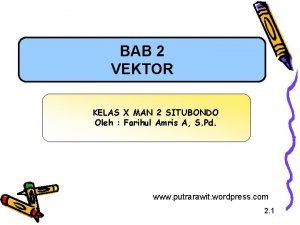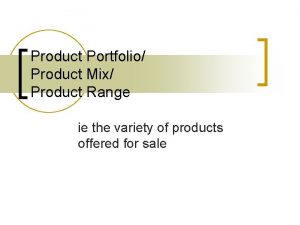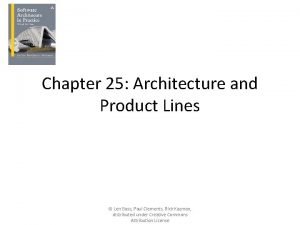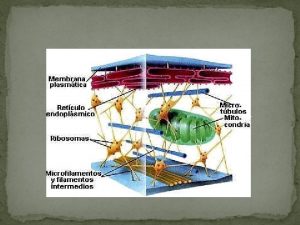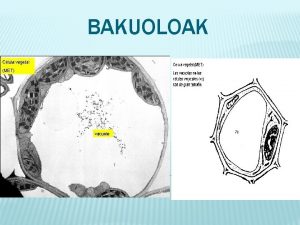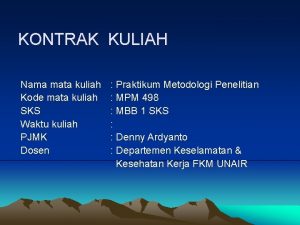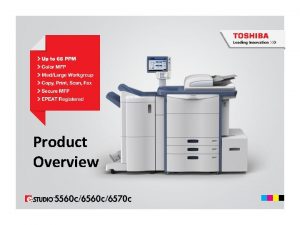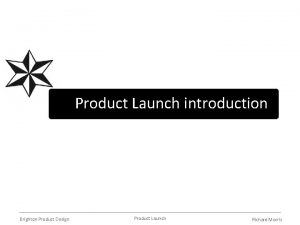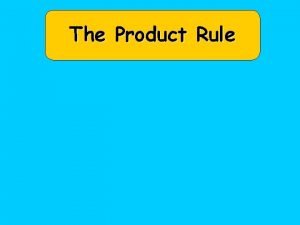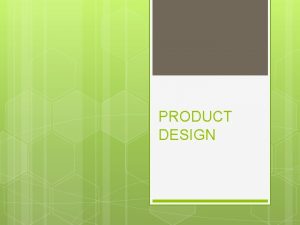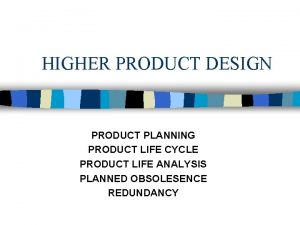Kuliah 9 Product Architecture Dira Ernawati ST MT
































- Slides: 32

Kuliah 9 : Product Architecture Dira Ernawati, ST. MT

Plannin g Concept Develop. System. Level Design Detail Design Testing And Refinement Production Ramp-Up Marketing Design Mfg Other Dira Ernawati, ST. MT 2

What is Product Architecture? The scheme by which the functional elements of the product are arranged into physical chunks and by which the physical chunks interact. Dira Ernawati, ST. MT 3

Elements of Product Architecture • Functional elements: individual operations and transformations that contribute to the overall performance of the product. • Physical elements: the parts, components, and sub-assemblies that ultimately implement the product’s functions. Dira Ernawati, ST. MT 4

Product Architecture • Physical elements are typically organized into several major building blocks: chunks • Each chunk: a collection of components that implement the functions of the product • The architecture of a product: the scheme by which the functional elements of the product are arranged into physical chunks and by which the chunks interact Dira Ernawati, ST. MT 5

Modular Architecture • chunks implement one or a few elements • interactions between chunks are well-defined and fundamental to the primary functions of the product • allows a design change in one chunk without requiring changes to other chunks • most modular: each functional element is implemented by exactly one chunk Dira Ernawati, ST. MT 6

Modular Architecture Examples • Xerox copier • Personal computer • Residential AC units Dira Ernawati, ST. MT 7

Integral Architecture • functional elements of the product are implemented using more than one chunk • a single chunk implements many elements • interactions between chunks ill-defined, may be incidental to the primary functions of the products • used with products with highest possible performance in mind Dira Ernawati, ST. MT 8

Integral Architecture Examples • High-performance transmission • Precision-ground bearings • Table knife Dira Ernawati, ST. MT 9

Slot-Modular Architecture • each interface between chunks different – various chunks cannot be interchanged • example: automobile radio - implements exactly one function, but interface different from any other components in the vehicle Dira Ernawati, ST. MT 10

Bus-Modular Architecture • a common bus to which chunks connect via the same type of interface • examples: track-lighting, shelving system with rails, expansion card for PC Dira Ernawati, ST. MT 11

Sectional-Modular Architecture • all interfaces of same type, but no single element to which all other chunks attach • assembly built by connecting chunks to each other via identical interfaces • examples: piping systems, office partitions Dira Ernawati, ST. MT 12

Implications of the Architecture Decisions about how to divide the product into chunks, and how much modularity, are linked to: • product change • product variety • manufacturability • product development management Dira Ernawati, ST. MT 13

Product Change - Motives • • • upgrade: technology or user needs evolve add-ons: add to basic unit; third-party adaptation: different use environments wear: replace elements, extend useful life consumption: replenish consumables flexibility in use: configured for different uses • reuse: new models from small changes Dira Ernawati, ST. MT 14

Product Variety Products built around modular architectures can be more easily varied without adding tremendous complexity to the manufacturing systems • example: Swatches - many different hands, faces, wristbands but small selection of movements and cases Dira Ernawati, ST. MT 15

Manufacturability • Product architecture directly affects the ability of the team to design each chunk to be produced at low cost • One DFM strategy involves minimization of the number of parts through component integration, but component integration across several chunks is difficult • DFM must start at system-level design Dira Ernawati, ST. MT 16

Product Development Management Modular and integral architecture demand different project management styles • modular - requires very careful planning during system-level design • integral - less planning during system-level, but more integration, conflict resolution, and coordination during detail design Dira Ernawati, ST. MT 17

Establishing the Architecture Four-step method: • Create a schematic of the product • Cluster the elements of the schematic • Create a rough geometric layout • Identify the fundamental and incidental interactions Dira Ernawati, ST. MT 18

Create a Schematic: a diagram of the team’s understanding of the elements of the product • physical concepts, critical components, and functional elements • if product is a complex system with hundreds of functional elements, group into fewer, higher level functions to be decomposed later Dira Ernawati, ST. MT 19

Schematic For A Wristwatch Dira Ernawati, ST. MT 20

Cluster the Elements of the Schematic To determine when there advantages to clustering, consider: • • geometric integration and precision function sharing capabilities of vendors similarity of design or production technology • localization of change • accommodating variety • enabling standardization Dira Ernawati, ST. MT 21

Create a Rough Geometric Layout Geometric layout in two- or three-dimensions • drawings • computer models • physical models • cardboard or foam • evaluate clustering • coordinate with industrial designers Dira Ernawati, ST. MT 22

Identify the Fundamental and Incidental Interactions • fundamental: those corresponding to the lines on the schematic that connect the chunks together; planned • incidental: those that arise because of the particular physical implementation of functional elements, or because of the geometric arrangement of the chunks • example: chunks creating motion may have vibration as an incidental interaction Dira Ernawati, ST. MT 23

Related System-Level Design Issues The four-step method for establishing architecture guides the early design activities, but more detailed activities remain: • defining secondary systems • establishing architecture chunks • creating detailed interface specifications Dira Ernawati, ST. MT 24

Defining Secondary Systems • many functional and physical elements not shown on schematic (for simplicity) • others may be conceived as system-level design evolves • examples: safety systems, power systems, structural supports • management issue: who takes on responsibility for their design? Dira Ernawati, ST. MT 25

Establishing Architecture Chunks • some chunks of a complex system may be complex systems themselves • each of these may have its own architecture - same issues, procedures apply as for the system Dira Ernawati, ST. MT 26

Creating Detailed Interface Specifications • as system-level design progresses, fundamental interactions need more refinement - as a result, specification of the interfaces need to be clarified • interfaces represent “contracts” between chunks - often detailed in formal specification documents Dira Ernawati, ST. MT 27

Summary • Product architecture: the scheme by which functional elements are arranged into physical chunks • Architecture decisions have farreaching implications • • product change, product variety component standardization product performance product manufacturablility Dira Ernawati, ST. MT 28

Summary (cont. ) • Key characteristic of a product architecture the degree to which it is modular or integral • Modular architectures - those in which each physical chunk implements a specific set of functional elements, and has well-defined interactions with other chunks • Three types of modular: slot-modular, bus-modular, sectional modular Dira Ernawati, ST. MT 29

Summary (cont. ) Integral architectures - those in which the implementation of functional elements is spread across chunks, resulting in ill-defined interactions between chunks Dira Ernawati, ST. MT 30

Summary (cont. ) Four-step method for establishing product architecture: • • Create a schematic of the product Cluster the elements of the schematic Create a rough geometric layout Identify the fundamental and incidental interactions Dira Ernawati, ST. MT 31

Summary (cont. ) • Four-step method leads the team through preliminary architectural decisions • Subsequent system-level and detail design activities contribute to a continuing evolution of the architectural details • Due to broad implications of architectural decisions, inputs from marketing, manufacturingand design are essential Dira Ernawati, ST. MT 32
 Ernawati sinaga
Ernawati sinaga Eli ernawati
Eli ernawati Dira lehaskir
Dira lehaskir Dira leads
Dira leads Como dira
Como dira Has o haz
Has o haz Product life cycle kotler
Product life cycle kotler Contoh produk gabungan
Contoh produk gabungan What is a firm
What is a firm Product mix and product line
Product mix and product line Core product actual product
Core product actual product Outer product cross product
Outer product cross product Chapter 3 feasibility study
Chapter 3 feasibility study Product line depth
Product line depth Contoh soal dot product dan cross product
Contoh soal dot product dan cross product Core product augmented product
Core product augmented product Product portfolio mix
Product portfolio mix Hasil kali silang cross product
Hasil kali silang cross product Gnp and gdp
Gnp and gdp Product line architecture example
Product line architecture example Product architecture example
Product architecture example Product architecture
Product architecture Software architecture foundations theory and practice
Software architecture foundations theory and practice Product line architecture example
Product line architecture example Productarchitectuur
Productarchitectuur Architecture business cycle in software architecture
Architecture business cycle in software architecture Call and return architecture in software engineering
Call and return architecture in software engineering Bus design in computer architecture
Bus design in computer architecture Database kuliah
Database kuliah Stress kuliah
Stress kuliah Mata kuliah etika profesi
Mata kuliah etika profesi Kuliah psikologi faal
Kuliah psikologi faal Https //kuliahonline.undira.ac.id
Https //kuliahonline.undira.ac.id














